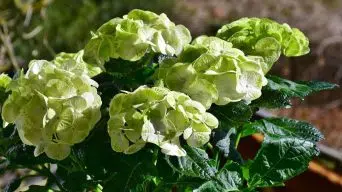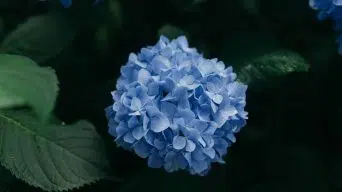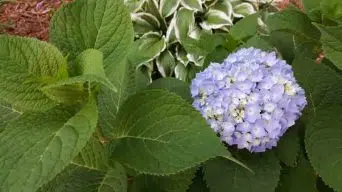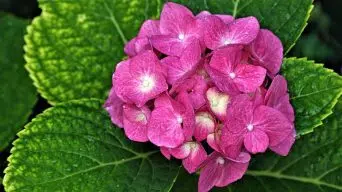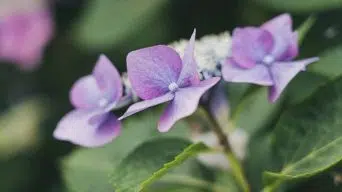White spots on hydrangea leaves can result from powdery mildew, pests, sunburn, mineral deposits, chemical burn, or nutrient deficiency. To address the issue, identify the cause and apply appropriate solutions, such as pruning, using fungicides, adjusting sunlight, or addressing nutrient imbalances.
Hydrangea plants are stunning in any garden but can be susceptible to several problems.
One common issue is white spots on the leaves.
There are a few different things that can cause this, so it’s essential to figure out the source of the problem before you can treat it.
Here are six possible causes of white spots on hydrangea leaves and some solutions.
What Causes White Spots on Hydrangea Leaves?
A few different things can cause white spots on hydrangea leaves.
Here are the most common culprits:
1. Powdery Mildew
One of the most common reasons for white spots on hydrangea leaves is powdery mildew.
Powdery mildew is a fungus that thrives in humid conditions and can quickly spread to cover the entire plant.
Powdery mildew is a fungal disease that will cause the leaves to develop a white or gray powdery substance on the surface.
How To Tell If Your Hydrangea Has Powdery Mildew
If you think your plant may have powdery mildew, look for the following symptoms:
- White or gray powdery substance on the leaves
- Stunted growth
- Leaves that are discolored or dying
- Buds that fail to open
How To Prevent Powdery Mildew On Hydrangeas
There are a few things you can do to prevent powdery mildew from infecting your plants:
- Water early in the day so the plant leaves have time to dry before nightfall.
- Space plants so they have good air circulation.
- Remove any infected plant leaves as soon as you see them.
- Avoid overhead watering, which can promote fungal growth.
- Avoid overwatering a Hydrangea, which can make the leaves more susceptible to powdery mildew.
- Disinfect your pruning tools after each use.
How To Treat Powdery Mildew On Hydrangeas
If your plant is already infected with powdery mildew, there are a few things you can do to treat it.
- Use baking soda: Mix 1 teaspoon of baking soda with 1 quart of water and spray it on the affected leaves.
- Use neem oil: Neem oil is a natural fungicide that can be used to treat powdery mildew. Mix 2 teaspoons of neem oil with 1 cup of water and spray it on the affected leaves.
- Use milk: Mix 1 part milk with 9 parts water and spray it on the affected leaves.
- Use a fungicide: Several fungicides can be used to treat powdery mildew. Be sure to follow the directions on the label carefully.
- Remove and destroy infected leaves: One of the best things you can do is to remove and destroy any leaves that are affected by powdery mildew. This will help to prevent the disease from spreading.
2. Pest Infestation
Another common cause of white spots on hydrangea leaves is a pest infestation.
Mealybugs, whiteflies, and scale insects are all common pests that can attack hydrangeas.
These pests will suck the sap out of the leaves, causing hydrangea leaves to turn yellow or white.
Act quickly if you think your plant has a pest infestation, as these pests can quickly spread and seriously damage your plant.
How To Tell If Your Hydrangea Has A Pest Infestation
There are a few things you can look for to tell if your plant has a pest infestation:
- White or yellow spots on the leaves
- Leaves that are wilting or dying
- Leaves have holes or are chewed
- Sticky substance on the leaves or stems
- Pests crawling on the plant
If you see any of these signs, you must take action immediately.
How To Prevent Pest Infestation On Hydrangeas
There are a few things you can do to prevent pests from infesting your plants:
- Inspect plants before you buy them.
- Quarantine new plants for a few weeks.
- Keep your plant clean and free of debris.
- Remove any dead or dying leaves or branches.
- Prune regularly to encourage healthy growth.
- Water at the base of the plant, not from overhead.
If you find pests on your plant, it’s essential to take action immediately.
How To Treat Pest Infestation On Hydrangeas
If your plant is already infested with pests, there are a few things you can do to treat it:
- Remove and destroy affected leaves.
- Prune infested branches.
- Hose down the plant with water to remove pests.
- Apply insecticidal soap or neem oil according to the directions on the label.
- Apply a horticultural oil according to the directions on the label.
3. Sunburn
Another common cause of white spots on hydrangea leaves is sunburn.
Hydrangeas are generally quite tolerant of sunlight, but the leaves can become sunburned if exposed to too much direct sunlight.
This will cause the hydrangea leaves to turn white or yellow and eventually drop off the plant.
It’s essential to know how much sun your Hydrangea plant can tolerate and to give it the appropriate amount of protection from the sun.
How To Tell If Your Hydrangea Is Suffering From Sunburn
There are a few things you can look for to tell if your plant is suffering from sunburn:
- Leaves that are wilted, brown, or dried out
- Leaves have white or yellow patches
- Blisters or raised bumps on the leaves
- Blooms that are faded or discolored
- Branches that are dead or dying
If you see any of these signs, you must take action immediately.
How To Prevent Sunburn On Hydrangeas
There are a few things you can do to prevent sunburn on your plant:
- Choose a location that gets partial sun or filtered sunlight.
- Plant in an area that provides some protection during the hottest part of the day.
- Make sure the plant has adequate airflow.
- Prune regularly to encourage healthy growth.
- Water regularly.
If you do find that your plant is suffering from sunburn, it’s essential to take action immediately.
How To Treat Sunburn On Hydrangeas
If your plant is already suffering from sunburn, there are a few things you can do to treat it:
- Move the plant to a location that gets indirect sunlight or filtered sunlight.
- Prune affected leaves and branches.
- Water the plant regularly.
4. Mineral Deposits
Another common cause of white spots on hydrangea leaves is mineral deposits.
Mineral deposits can build up on your plant’s leaves, causing them to turn white or yellow.
This is often caused by water that is high in mineral content, such as hard water.
It can also be caused by using a high mineral content fertilizer.
How To Tell If Your Hydrangea Has Mineral Deposits
There are a few things you can look for to tell if your plant has mineral deposits:
- The leaves are covered in whitish spots with a crusty texture.
- The spots are found on the upper surfaces of the leaves.
- The spots are more common on new growth.
- The leaves may yellow and drop off prematurely.
If you see these signs, your plant likely has mineral deposits.
How To Prevent Mineral Deposits On Hydrangeas
There are a few things you can do to prevent mineral deposits on your plant:
- Use only distilled water or rainwater.
- When using tap water, let it sit for 24 hours before using it on your plant. This will allow the chlorine to evaporate.
- Choose a fertilizer that is low in minerals.
- Flush the soil with water every few weeks to remove excess minerals.
- Prune regularly to encourage healthy growth.
If you do find that your plant has mineral deposits, it’s essential to take action immediately.
How To Treat Mineral Deposits On Hydrangeas
If your plant already has mineral deposits, there are a few things you can do to treat it:
- Use a soft brush to remove any deposits on the leaves’ surface gently.
- Mix equal parts of water and white vinegar, and use this solution to wipe down the affected leaves.
- Wash the leaves with a mild soap or detergent. This will remove any build-up of minerals on the surface of the leaves.
- If the problem is severe, you can cut off the affected leaves and dispose of them.
- Don’t fertilize the plant for a few months to allow the mineral deposits to break down.
5. Chemical Burn
Another common cause of white spots on hydrangea leaves is chemical burn.
A chemical burn can be caused by using a fertilizer that is too high in nitrogen or by using an herbicide or pesticide that is too strong.
It can also be caused by exposure to chemicals in the environment, such as car exhaust or factory emissions.
How To Tell If Your Hydrangea Has A Chemical Burn
There are a few things you can look for to tell if your plant has a chemical burn:
- The leaves are covered in white spots.
- The edges of the leaves are brown or black.
- The leaves may yellow and drop off prematurely.
- The plant may be stunted or have unhealthy growth.
If you see these signs, your plant likely has a chemical burn.
How To Prevent Chemical Burn On Hydrangeas
There are a few things you can do to prevent chemical burn on your plant:
- Choose a fertilizer that is low in nitrogen.
- When using pesticides or herbicides, be sure to follow the instructions carefully.
- Avoid using chemicals near your plant.
If you do find that your plant has a chemical burn, it’s essential to take action immediately.
How To Treat Chemical Burn On Hydrangeas
If your plant already has a chemical burn, there are a few things you can do to treat it:
- Wash the leaves with a mild soap or detergent. This will remove any build-up of chemicals on the surface of the leaves.
- If the problem is severe, you can cut off the affected leaves and dispose of them.
- Don’t fertilize the plant for a few months to allow the chemical burn to heal.
- Apply a diluted solution of water and vinegar to the leaves. This will help to neutralize the chemicals.
6. Nutrient Deficiency
A nutrient deficiency can also cause white spots on hydrangea leaves.
Hydrangeas need certain nutrients to grow healthy and strong.
When they don’t get enough of these nutrients, it can cause problems such as yellowing leaves, stunted growth, and white spots.
The most common nutrient deficiencies that affect hydrangeas are:
- Iron deficiency
- Calcium deficiency
- Magnesium deficiency
How To Tell If Your Hydrangea Has A Nutrient Deficiency
There are a few things you can look for to tell if your plant has a nutrient deficiency:
- The leaves are small and stunted
- There are fewer leaves than normal
- The leaves are yellow or pale green
- The leaves have white spots or patches
If you see any of these signs, your plant may be lacking in one or more essential nutrients.
How To Prevent Nutrient Deficiency In Hydrangeas
There are a few things you can do to prevent nutrient deficiency in your plant:
- Choose a fertilizer that is high in essential nutrients.
- Add compost or manure to the soil around the plant.
- If you live in an area with hard water, use distilled water for your plant.
- Water the plant regularly and deeply.
- Make sure the plant has enough light.
How To Treat Nutrient Deficiency In Hydrangeas
If your plant already has a nutrient deficiency, there are a few things you can do to treat it:
- Use a balanced fertilizer.
- Apply the fertilizer to the soil around the base of the plant.
- Water the plant deeply after applying the fertilizer.
- Repeat as needed until the deficiency is corrected.
- If the deficiency is severe, you may need to add a soil amendment to the soil.
Final Thoughts
Hydrangea care is relatively simple, but even the most well-cared for plants can succumb to disease or pests.
If your plant has white spots on its leaves, it’s essential to take action quickly to determine the cause and treat the problem.
Most importantly, don’t panic!
With a little investigation and some TLC, your hydrangea plant will return to its beautiful self in no time.


